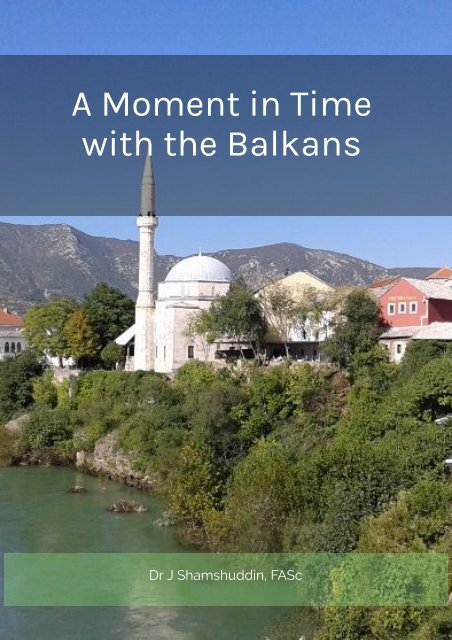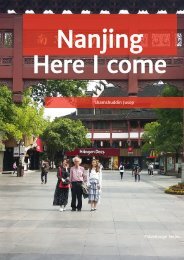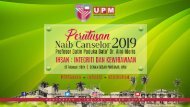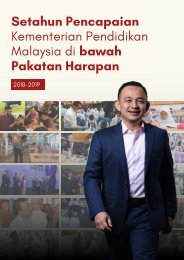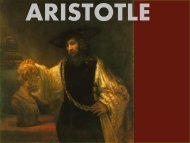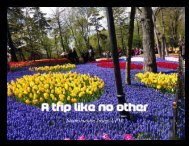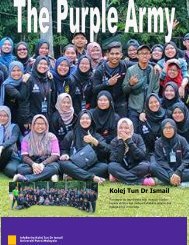You also want an ePaper? Increase the reach of your titles
YUMPU automatically turns print PDFs into web optimized ePapers that Google loves.
A Moment in Time<br />
with the <strong>Balkan</strong>s<br />
Dr J Shamshuddin, FASc
Travelogue Series<br />
A Moment in Time with the <strong>Balkan</strong>s<br />
In October 2015, my wife, daughter and I were in the <strong>Balkan</strong> state of Croatia for work cum holidays for a few<br />
days. I was scheduled to present a keynote paper at the 9<br />
th<br />
International Symposium on Plant-Soil<br />
Interaction at Low pH (9<br />
th<br />
PSILPH) in Dubrovnik, Croatia on October 18-23, 2015. It was a perfect holiday for<br />
me and my loved ones for we have never been in that locality in our life time. To get to Dubrovnik on time<br />
for the symposium, we had to first fly to Frankfurt, Germany by Lufthansa, had a 4 hours break at the airport<br />
(Plate 1) and took off to Dubrovnik by Croatian Airlines.<br />
Plate 1. At Frankfurt Airport with Dr Radziah (left) and Dr Wan Rashidah (right) en route to Dubrovnik, Croatia<br />
to attend the 9<br />
th<br />
PSILPH<br />
Croatia is a country of more than 1000 islands, with many visitors going there in summer for holidays,<br />
especially to the old city of Dubrovnik (Plate 2). This city used to be the playground of the rich and famous<br />
during the middle ages. Lately, however, Hollywood movies among the like of The Games of Throne were<br />
filmed in the city and these have attracted many more tourists to visit the ancient city.<br />
A Moment in Time with the <strong>Balkan</strong>s<br />
Page 1
Travelogue Series<br />
th<br />
The 9 PSIPLH was held in Dubrovnik, Croatia the first time ever on October 18-23, 2015. The venue of the<br />
symposium was none other than the well-known Neptune Hotel, Dubrovnik (Plate 3). Croatia is a country of<br />
barren rocky hills (Plate 4) made of limestone (Plate 5), with low amount of rainfall throughout the year. The<br />
Malaysian Society of Soil Science (MSSS) was represented at the world-class symposium by its three<br />
prominent members (Plate 1) – the President of MSSS (Dr Wan Rashidah), the Head of Department of Land<br />
Management, UPM (Dr Radziah) and me (a Fellow of the MSSS). For your information, I was once the<br />
President of MSSS and very active in the activities of the society.<br />
Plate 2. A cruise ship at docked at the Port of Dubrovnik<br />
Plate 3 shows a beautiful sunset at Dubrovnik as seen from the Neptune Hotel. This photograph was taken<br />
one evening just before dinner time from the verandah of the hotel during the symposium. For all you know,<br />
most hotels in Croatia are built on steep land fronting rocky beaches. For reasons best known to the people<br />
staying at the resort, nobody dared jumped into the deep and dangerous crystal clear seawater for a swim.<br />
The area is not shark-infested though.<br />
Moment in Time with the <strong>Balkan</strong>s<br />
Page 2
Travelogue Series<br />
Plate 3. Neptune Hotel, Dubrovnik where the symposium was held<br />
Common natural landscapes in the mountainous Croatia are shown in Plate 4. The hills are deprived of<br />
vegetation due to the presence of impenetrable hard rocks without much water available for plants to grow.<br />
Roads are costly or even dangerously constructed along the rugged limestone landscape with great<br />
difficulty. Hence, boats and ships are a more common transport for the people in this country than those of<br />
cars or buses.<br />
Plate 4. Common landscape features in<br />
the limestone-dominated Croatia<br />
Limestone rocks dipping deeply into<br />
the sea at the rocky beaches shown in<br />
Plate 5 are one of the most common<br />
landscape features throughout Croatia.<br />
Neptune Hotel is constructed on<br />
limestone of this nature. For sure, the<br />
hotel is safe and sound as it is built on<br />
solid rocks.<br />
A Moment in Time with the <strong>Balkan</strong>s<br />
Page 3
Travelogue Series<br />
Pate 5. A close-up picture of limestone rocks on which Neptune Hotel was built<br />
Plate 6 shows some of the members of the International Steering Committee of which I am a member since<br />
2004; this committee is responsible for organizing and maintaining the quality of the symposium throughout<br />
the years of its existence. However, the symposium proper is franchised to the local organizer for ease of<br />
managing it. This time around the job was assigned to a public university in Croatia. The members of the<br />
steering committee are downright prominent scientists from many regions of the world where acid soils are<br />
widespread, such as American continent, Europe, China, Japan, Australia and ASEAN countries.<br />
Plate 6. Members of the International Steering<br />
Committee that organized the symposium<br />
This time around, the chairman of local<br />
organizing committee was headed by Prof<br />
Zdenko Loncaric of Croatia who was also a<br />
member of the international steering committee;<br />
in Plate 7, he is standing at number 3 from the<br />
right. The person to his right is Prof Inubushi of<br />
Japan who represented the International Union<br />
of Soil Science at the 9<br />
th<br />
PSILPH.<br />
A Moment in Time with the <strong>Balkan</strong>s<br />
Page 4
Travelogue Series<br />
Plate 7. With some of the symposium’s delegates<br />
I took some time off from the symposium to see places in Croatia. We first headed towards the old city of<br />
Dubrovnik which was a few km away from the venue of the symposium. It was only a few minutes ride to<br />
get there by shuttle bus. The city is known to have many state-of-the-art marinas where boats and yachts<br />
belonging to the locals and foreigners are berthed (Plate 8), while their owners are having quality time on<br />
land or looking for adventures in the ancient city.<br />
Plate 8. Having quality time with my wife at the<br />
Dubrovnik old city<br />
Members of my family followed the midconference<br />
tour of the symposium. We were<br />
taken to places of interest to scientists and<br />
tourists alike. One of the stops was a small<br />
historical town having Great Wall of China-like<br />
monument (Plate 9). This mini great wall was<br />
under the state of disrepair or neglected for a<br />
long time, but now it is under renovation. It was<br />
first built by the rulers of Dubrovnik during the middle ages to mark her territorial boundary.<br />
A Moment in Time with the <strong>Balkan</strong>s<br />
Page 5
Travelogue Series<br />
Plate 9. In the background was wall constructed to mark a territory<br />
Croatia is known for producing good wine. On the way to one of its wineries, we saw grape vineyards burnt<br />
to the ground by wild fires (Plate 10). This fire disaster is a very often phenomenon occurring during dry<br />
summer time in Croatia. The annual rainfall in the country is about 700 mm and hence in case of outbreak<br />
of fire the authority has to engage a small plane to put it off. This is a very costly affair for a poor country like<br />
Croatia.<br />
Plate 10. Grape vineyards being destroyed by fire<br />
I extended my stay another day in Croatia after the<br />
symposium to visit Bosnia, which once together with<br />
Croatia was under the former Republic of Yugoslavia,<br />
established after the 2<br />
nd<br />
World War. The country<br />
went into trouble and had since broken into a few<br />
small republics, with Croatia joining the European<br />
Union. On the way to Bosnia, we were brought to the<br />
countryside where agricultural production in Croatia<br />
was in action (Plate 11).<br />
A Moment in Time with the <strong>Balkan</strong>s<br />
Page 6
Travelogue Series<br />
Plate 11. Agricultural activities in the lowlands of Croatia<br />
At the Bosnia border, we stumbled upon an old village with clear Islamic culture still intact, shown by the<br />
presence of an ancient mosque with special minaret and other Muslim monuments (Plate 12). Bosnia was<br />
once ruled by the Ottoman Turks and therefore remnants of their cultures can be seen everywhere in the<br />
country, especially in the countryside and/or towns. After defeating the Romans in 1453, the Ottoman Turks<br />
spread their wing to the other parts of the <strong>Balkan</strong>. Their brilliant military strategies and excellent<br />
administrative policy had won the respect, heart and mind of the locals. In carrying out administrative<br />
duties, justice not only be done, but also be seen to be done. In the end, many locals converted to Islam on<br />
their own accord, based on trust and respect. They remain so until today, especially those living in Bosnia.<br />
However, for some reasons, the Muslim Bosnians are unable to catch up with the pace of economic<br />
activities enjoyed by the developed West; thus, many of them remained poor (Plate 13). I, for one, believe<br />
that if we want to help Muslim brothers, as part of our jihad, to achieve economic independence from the<br />
West, Bosnia is the place to be.<br />
A Moment in Time with the <strong>Balkan</strong>s
Travelogue Series<br />
Plate 12. An old mosque built by the Ottoman Turks at a village near the border<br />
Plate 13. Poor Muslim Bosnians selling souvenirs near the<br />
old mosque<br />
A Moment in Time with the <strong>Balkan</strong>s<br />
Page 8
Travelogue Series<br />
Mostar is by comparison a small city, split into 2 parts; the Muslim and Croats sides. This happened soon<br />
after the war in the 1990s between the two ethnic groups. I opine that they should get to business by being<br />
together again as a people of one nation, sooner rather than later. Like everywhere else in Bosnia, there is<br />
not many job opportunities in the city. It has only one factory producing aluminum products that employs<br />
about 1000 workers. As far as I know, its economy depends a lot on tourism or funds from foreign donors.<br />
Selling souvenirs in the shops is one of the most common job opportunities for the local youth and of<br />
course some work as tourist guides. How much money they can earn in a month is anybody’s guess. For<br />
the Bosnians, I could really feel that they needed our help to get them back to where they were before the<br />
war. The first order of business for anyone willing to help them is to set up educational centers in the city to<br />
teach the Bosnia youth skills for making a living in a country with limited resources.<br />
Mostar, for all we know, was destroyed by the war and it is slowly being built with the help of international<br />
donation (Plate 14). The most important landmark in the city is the Old Bridge of Mostar (Plate 15), which had<br />
been immortalized in novels and films for many years. This famous bridge, built by the Ottoman Turks in 17th<br />
Century, was completely destroyed during the Bosnia-Croat war, but it is being restored to its original<br />
specification with the help of international experts. On the bridge shown in Plate 15, you see some people<br />
walking on it. To attract attention from visitors in the vicinity, a stunt jump from the bridge at regular interval<br />
is organized. It is about 30 m fall into the greenish cool flowing water of the river.<br />
Plate 14. At Mostar old city with the famous old bridge in the background<br />
A Moment in Time with the <strong>Balkan</strong>s<br />
Page 9
Travelogue Series<br />
Plate 15. A close-up picture of the Old Bridge of Mostar<br />
From the bridge I could see from a distance the Grand Mosque of Mostar (Plate 16). This old but beautiful<br />
and well-known mosque was built by the Ottoman Turks in 17<br />
th<br />
Century when Bosnia was under their rule.<br />
A walk to the mosque area one could see the mosque courtyard with all its beauty and splendor (Plate 17).<br />
The courtyard, although small by any measure, has a beautiful surrounding with running water fountains. It<br />
is here that tourists concentrate and take pictures as token of memory to the historical site. Many halal food<br />
eateries are available within a walking distance from the mosque. Using a toilet within the mosque area<br />
could cost 0.5 Euro. To walk up the mosque’s minaret for a bird-eye view of the old city would cost another<br />
2 Euro. This money, for all intents and purposes, is needed for keeping and maintaining the mosque and its<br />
area – regard the money paid as a donation to the local Muslim community in Mostar.<br />
Plate 16. A mosque in Mostar built by the<br />
Ottoman Turks in 1618<br />
A Moment in Time with the <strong>Balkan</strong>s<br />
Page 10
Travelogue Series<br />
Plate17. Tourists enjoying the beautiful<br />
surrounding Grand Mosque courtyard<br />
On the way to the Grand Mosque, we walked through the main thoroughfare of the old city of Mostar. The<br />
street was lined up with souvenir shops and restaurants of all kinds. It was here that we went for a bargain<br />
to get to the best choice of souvenirs in terms of cost and quality.<br />
While walking along the street and seeing things in the old city, I couldn’t help thinking about the problems<br />
and fate of the Bosnia poor. The shopkeepers and salesmen seemed to recognize Malaysians easily by our<br />
look and the way we dressed. Some kids were found begging from the tourists. Instead of going to school,<br />
they were on the streets begging for money to support the living expenses of their families. After buying<br />
something from their shops, they thanked us profusely for our kindness and generosity. A few salesgirls<br />
hugged my wife and said that Malaysians had money and they were happy to see us. I was really disturbed<br />
to the core of my heart on seeing these turn of events.<br />
A Moment in Time with the <strong>Balkan</strong>s<br />
Page 11
Travelogue Series<br />
Plate 18. The main thoroughfare in Mostar old city<br />
th<br />
The 9 PSILPH was attended by many prominent scientists<br />
in the field of soil science and plant physiology from the four<br />
corners of the world. It was a good meeting and I was very<br />
satisfied with the quality of the papers presented. We were<br />
able to exchange notes and ideas with the great minds in<br />
soil science and plant physiology, who are working tirelessly<br />
to enhance the productivity of crops grown on acid soils. We<br />
had real good discussion on the papers presented during<br />
the symposium. There is good news to share with you<br />
though. The 10<br />
th<br />
PSIPLH will be held in Malaysia, to be organized by UPM, with the support of MSSS. The<br />
proposed venue was the Marriott Putrajaya to be held late June 2018.<br />
God bless UPM and God bless you all.<br />
Dr J Shamshuddin, FASc<br />
A Moment in Time with the <strong>Balkan</strong>s<br />
Page 12
Travelogue Series<br />
A Moment in Time with the <strong>Balkan</strong>s<br />
Page 13


